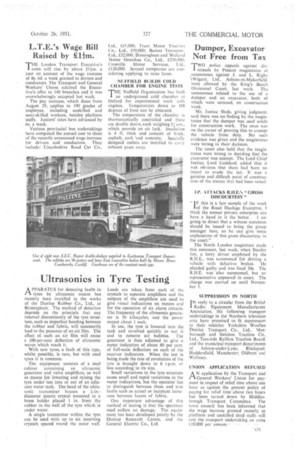Ultrasonics in Tyre Testing
Page 33

If you've noticed an error in this article please click here to report it so we can fix it.
A PPARATUS for detecting faults in -1-1 tyres by ultrasonic means has recently been installed in the works of the Dunlop Rubber Co., Ltd.., at Birmingham. The method of detection depends on the principle that any internal discontinuity of the tyre structure, such as imperfect bonding between the rubber and fabric, will necessarily lead to the presence of an air film. The effect ofsuch an air film will cause a 100-per-cent deflection of ultrasonic waves which reach it.
With new tyres, a fault of this type, whilst possible, is rare, but with used tyres it is common.
The equipment consists of a steel cabinet containing an ultrasonic generator and valve amplifiers, as well as means for lowering and raising the tyre under test into or out of an adjacent water tank. The head of the ultrasonic transmitter houses a
diameter quartz crystal mounted in a brass holder placed 1 in. from the rubber in the well of the tyre which is under water.
A single transmitter within the tyre can be used with up to six receiving crystals spaced round the outer wall. Leads are taken from each of the crystals to separate amplifiers and the outputs of the amplifiers are used to give visual indications on meters and for the operation of six alarm circuits. The frequency of the ultrasonic generator is 50 kilocycles, and the power output about 1 watt.
In use, the tyre is lowered into the tank and revolved quickly to wet it and to remove air bubbles. The generator is then adjusted to give a meter indication of about 80 per cent. of full-scale deflection on each of the receiver indicators. When the test is being made the rate of revolution of the tyre is brought down to 6 r.p.m. or less according to its size.
Small variations in the tyre structure cause small and. rapid variations in the meter indications, but the operator has to distinguish between these and true faults such as actual or incipient looseness between layers of fabric.
One important advantage of this method of testing is that the specimen used suffers no damage. The equipment has been developed jointly by the Dunlop Research Centre, and he General Electric Co., Ltd,




















































































